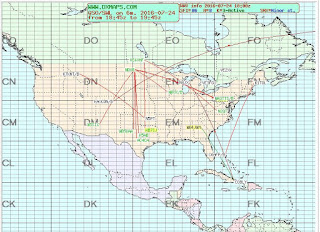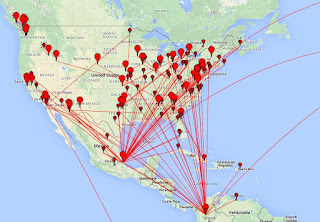I have been having fun on 6m every summer since the late 60's. Without doubt, this summer's Sporadic-E (Es) season is the worst one I have experienced in terms of domestic (North America) openings. This summer was almost a carbon-copy of last year's summer Es season. As I mentioned in
an earlier blog, unless this is some form of short term or cyclical anomaly, the fundamental nature of Sporadic-E openings appears to be undergoing some type of change. Missing-in-action were the numerous day-long intense openings to California as well as the grand openings to the eastern states (FN grids) and Canada ... all guaranteed openings every summer. These openings would often last well into the late night hours and even overnight, picking up the next day where they left off. This is the second summer in a row where no Es MUF's into the 2m band were experienced, with this year having seen nothing even as high as the 88-108MHz FM band. Maybe I missed them if they occurred, but I don't think so.
In terms of non-domestic openings, the band continues to evolve, as it seems that a higher percentage of hours with very long skip continues to rise. As poor as this year has been domestically, CW contacts were completed with Germany, Ireland, England, Japan, France, Canary Islands, Balearic Island, Venezuela, Cuba, Puerto Rico, and the Cayman Islands. A short and exceptionally rare opening to Africa, allowed an 'almost QSO' with CN8KD in Morocco, as he had one letter of my call incorrect when he quickly faded away ... pretty exciting even for a 'busted' QSO on 6m, in the middle of summer. Whether this very long propagation is just multi-hop traditional Es or something entirely different is still up for debate, as often there are no indicators (beacons or other mid-point signals) indicating that the band is even open. Many, including myself, believe this is some form of chordal hop or interlayer ducting, involving the E-layer alone or perhaps even the bottom of the F layer. Signals strengths can reach 599 levels and almost without fail, have extremely small footprints, with stations just a few miles away hearing nothing at all.
When these openings occur between western North America and Europe, they can be very exciting, as the footprint on the European end often sprays around like a stray garden hose, popping up in a different country with each passing minute. Openings are often fast and furious and always heart-pounding! Perhaps there is still some magic yet to occur but the 'normal' season (or what used to be normal) is drawing to a close as August nears. The fat-lady is warming up her voice behind the curtain and will soon be singing once again. But something else is changing on 6m besides the propagation and that is the huge growth of the JT65 weak signal digital mode. As the season draws slowly down, I still see long-time dedicated CW operators going up the band to dip their toes for the first time on this alternate mode. I have used it fairly often to work stations when the CW / SSB end of the band appears to be dead. The maps shown below, grabbed just four days ago, illustrate what I have been seeing. The amount of JT65 activity is striking, compared to the traditional CW/SSB modes, both shown
for the same one hour period. I could assume that the several extra db of weak-signal sensitivity is the reason for the disparity seen from one mode to the other but there may be other factors coming into play.
Once the band really opens however, the weak-signal sensitivity of JT65 soon looses its previous advantage and the JT65 segment of the band can get pretty clobbered, with numerous signals on top of each other, all competing for their ~200Hz slice of the spectrum. As well, a JT65 QSO is slow ... a minimum of four minutes. Taking four minutes to exchange calls, reports and 'rogers' on a wide open band with strong signals, makes little sense. Perhaps the majority of 6m JT65 operators are new amateurs with a codeless licence or are operating in antenna-restricted communities. Whatever the reason, the numbers are growing and traditional operating patterns are changing. Who knows what next summer will bring!
 Magicband Morphs
Magicband Morphs
















